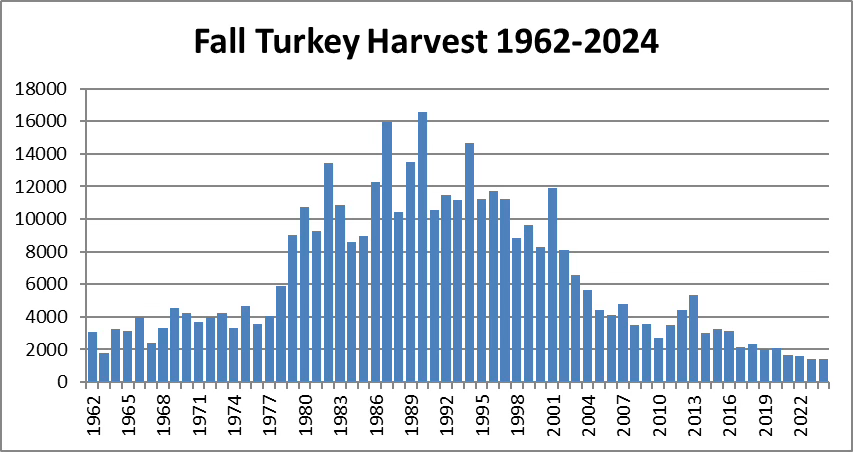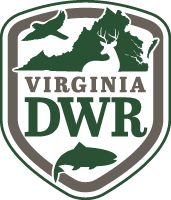A total of 1,423 wild turkeys were harvested in Virginia during the 2024–25 fall turkey hunting season, just slightly below the 2023–24 season total of 1,443.
While Virginia’s turkey population appears to remain robust, fall turkey harvests have been declining for over two decades. A recent DWR survey of turkey hunters indicated that many turkey hunters are choosing to save their turkey tags for the more popular spring turkey season and that they choose to pursue other game during the fall.
One of the largest drivers of fall hunting success is the annual productivity of Virginia’s turkey population. In 2024, the productivity estimate (2.1 poults/hen) was below the long-term average (2.6 poults/hen) for the third year in a row, but slightly up from just 1.89 poults/hen reported in 2023. However, there were significant regional variations this year with the Northern Piedmont and the North Mountain Regions performing above average (2.7 and 2.8 poults/hen, respectively). Since juvenile birds account for 40-60% of the fall harvest, population productivity greatly influences turkey population size and fall harvest.
As in the last several years, the archery harvest remained relatively high, making up approximately 22% of the overall harvest. Thanksgiving Day and the Wednesday before Thanksgiving continue to be popular fall turkey hunting days. This year a total of 400 birds were harvested during that two-day timeframe, accounting for 28% of the total fall harvest. Thanksgiving Day accounted for the single highest day of fall harvest with 266 birds (19%).
The declines in harvest were most apparent West of the Blue Ridge, with a decrease of 6%, as opposed to a slight increase of 3% East of the Blue Ridge. The greatest declines were noted in the Southwest Mountains (-22%) and Southern Piedmont (-21%) regions. The Southwest Mountain region reported significantly lower poult/hen ratios (1.1 poults/hen) which suggests that the lack of reproduction likely affected the harvest in that region. The harvests in the Tidewater and Northern Mountains increased from the previous year (48% and 31%, respectively).
DWR is currently working to revise the turkey management plan. Fall turkey hunting participation is one of the issues that is closely being monitored as this plan is in development. A draft of the management plan should be available for public review in Spring of 2025. For additional details on wild turkey management in Virginia, please visit our wild turkey web page.
County-by-County Fall Turkey Harvest Data (2024–2025)
Fall Turkey Harvest Data by County: Five-Year Trends
Virginia Fall Wild Turkey Harvest Data
| Season/Method | Number Harvested | % Total Harvest |
|---|---|---|
| Total Harvest | 1,423 | 100 |
| Type of Turkey | ||
| Without Beard | 722 | 50.7 |
| Beard <7” | 210 | 14.8 |
| Beard >7” | 491 | 34.5 |
| Region | ||
| East of Blue Ridge | 773 | 54.3 |
| West of Blue Ridge | 650 | 45.7 |
| Land Type | ||
| Private | 1,334 | 93.7 |
| Federal | 64 | 4.5 |
| State | 25 | 1.8 |
| Time Frame | ||
| Archery | 313 | 22.0 |
| Youth/Apprentice | 9 | 0.6 |
| First Two Weeks | 184 | 12.9 |
| Wed. & Thanksgiving | 400 | 28.1 |
| December | 418 | 29.4 |
| January | 69 | 4.8 |
| Weapon | ||
| Rifle | 545 | 38.3 |
| Shotgun | 511 | 35.9 |
| Muzzleloader | 42 | 3.0 |
| Bow | 111 | 7.8 |
| Crossbow | 212 | 14.9 |
| Pistol | 2 | 0.1 |
| Region | ||
| 1 (Tidewater) | 331 | 23.3 |
| 2 (South Piedmont) | 266 | 18.7 |
| 3 (SW Mtn) | 377 | 26.5 |
| 4 (NW Mtn) | 273 | 19.2 |
| 5 (North Piedmont) | 176 | 12.4 |


